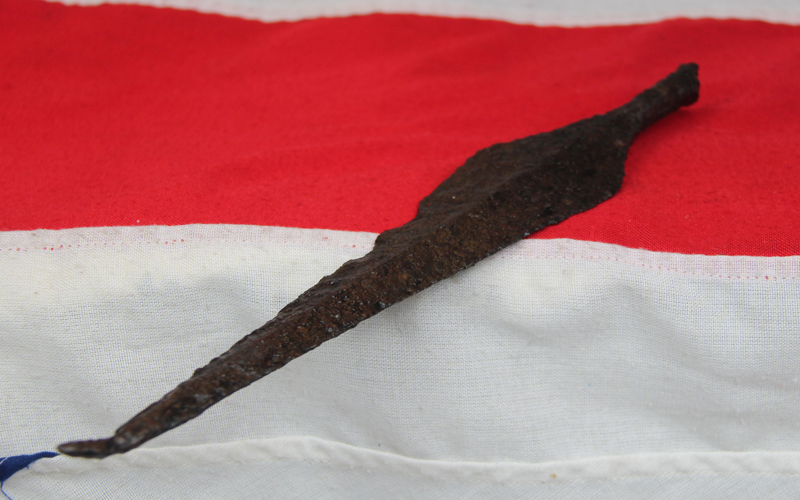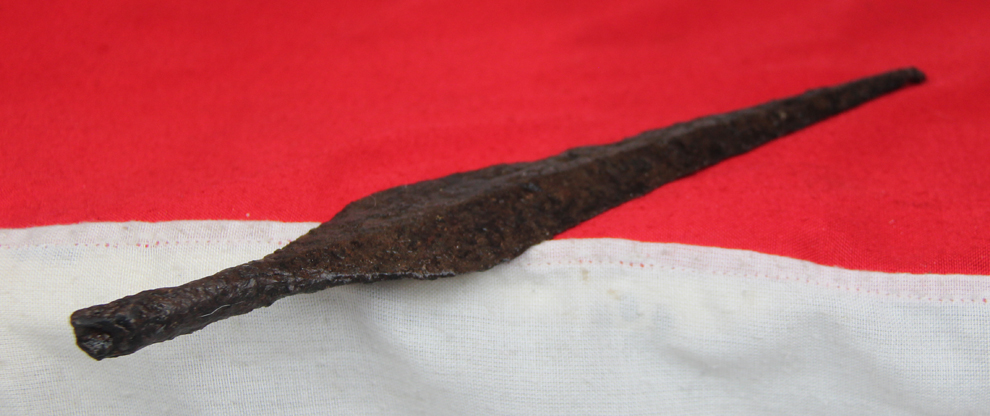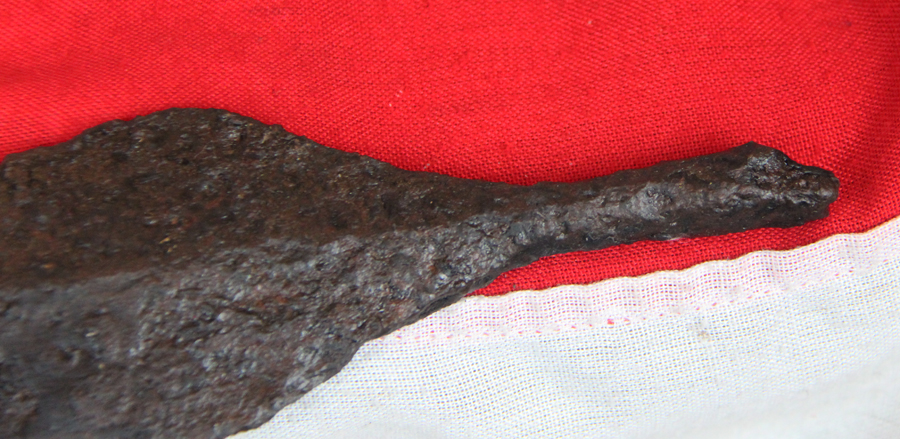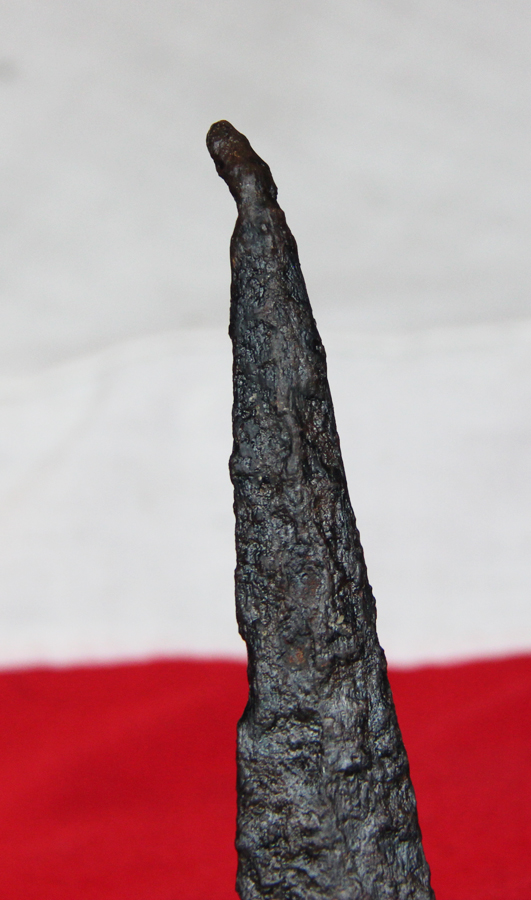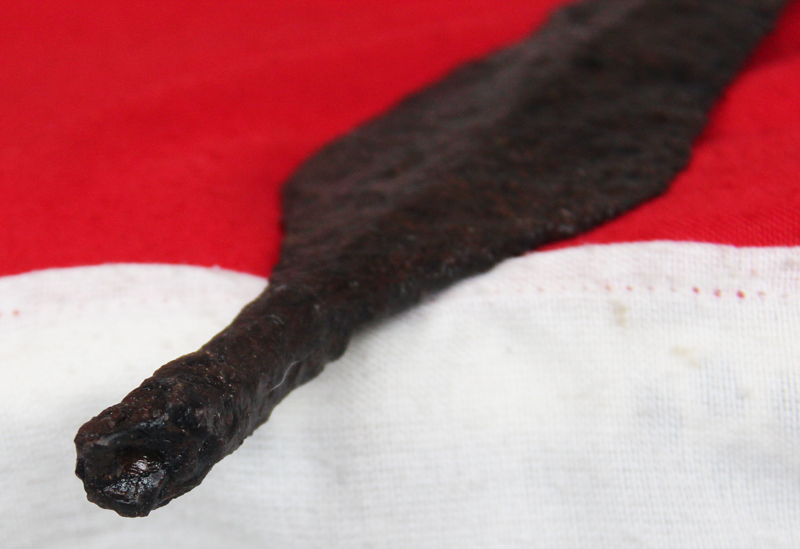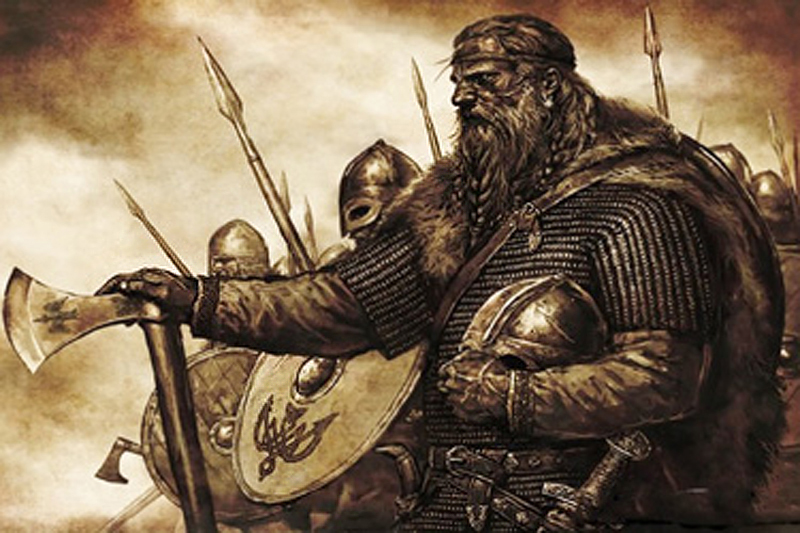A Fabulous & Impressive Large 10th Century Original Viking Spear, Classified as 'Petersen type G'... Vápnum sínum skal-a maðr velli á feti ganga framar, því at óvíst er at vita, nær verðr á vegum úti geirs of þörf guma
From the 13th century Codex Regius, a collection of Old Norse poems from the Viking Age. Verse 38 quoted above is translated here;
Let a man never stir on his road a step
without his weapons of war;
for unsure is the knowing when need shall arise
of a spear on the way without.
Circa 10th century. A fabulous example of an original Viking war spear.
Using the Petersen scale of dating swords axes and spears of the medieval era, it is around 1100 years old, and in super condition for its age. With a slightly impacted tip, possibly bent from penetration of mail armour or shield. With edge shoulders placed low on the blade and a short conical socket with marked narrowing below the blade. Although not as glamorous as the sword, the spear was in every sense the definitive weapon of the Viking Age and used as the primary weapon of combat by almost every warrior. Decorated spearheads inlaid with precious metals prove that in the Viking Age spears were not seen as the poor man's choice and one has only to look at the representations of warriors from the illuminated manuscripts of the era to quickly come to the conclusion that the use of the spear was ubiquitous. Many of the Anglo-Saxon phrases used to describe both battle and warrior help to underline the importance of the spear.
The spearheads were made of iron, and, like sword blades, were made using pattern welding techniques (described in the article on swords) during the early part of the Viking era . They could be decorated with inlays of precious metals or with scribed geometric patterns
After forming the head, the smith created the tang in the early period, such as for a javelin type spear, or in the later Viking mostly a socket fitting for a regular spear. Sometimes with holes for rivets to grip onto the haft.
However, there is little evidence that tells us the length of the shaft. The archaeological evidence is negligible, and the sagas are, for the most part, silent. Chapter 6 of Gísla saga tells of a spear so long-shafted that a man's outstretched arm could touch the rivet. The language used suggests that such a long shaft was uncommon.
Perhaps the best guess we can make is that the combined length of shaft and head of Viking age spears was 2 to 3m (7-10ft) long, although one can make arguments for the use of spears having both longer and shorter shafts. A strong, straight-grained wood such as ash was used. Many people think of the spear as a throwing weapon. One of the Norse myths tells the story of the first battle in the world, in which Odin, the highest of the gods, threw a spear over the heads of the opposing combatants as a prelude to the fight. The sagas say that spears were also thrown in this manner when men, rather than gods, fought. At the battle at Geirvör described in chapter 44 of Eyrbyggja saga, the saga author says that Steinþórr threw a spear over the heads of Snorri goði and his men for good luck, according to the old custom. More commonly, the spear was used as a thrusting weapon. The sagas tell us thrusting was the most common attack in melees and one-on-one fighting, and this capability was used to advantage in mass battles. In a mass battle, men lined up, shoulder to shoulder, with shields overlapping. After all the preliminaries, which included rock throwing, name calling, the trading of insults, and shouting a war cry (æpa heróp), the two lines advanced towards each other. When the lines met, the battle was begun. Behind the wall of shields, each line was well protected. Once a line was broken, and one side could pass through the line of the other side, the battle broke down into armed melees between small groups of men.
Before either line broke, while the two lines were going at each other hammer and tongs, the spear offered some real advantages. A fighter in the second rank could use his spear to reach over the heads of his comrades in the first rank and attack the opposing line. Konungs skuggsjá (King’s Mirror), a 13th century Norwegian manual for men of the king, says that in the battle line, a spear is more effective than two swords
Part of an original medieval collection we have acquired, of Viking and early British relics of warfare from ancient battle sites recovered up to 220 years ago. 14 inches long.
Almost every iron weapon that has survived today from this era is now in a fully russetted condition, as is this one, because only a very few of the swords of kings, that have been preserved in national or Royal collections can today be still in a relatively good state and surface condition. However, Bronze Age swords, daggers etc. that are usually much earlier, survive far better as they only suffer from surface ageing and patination, unlike iron and steel weaponry, which makes early iron weapons so incredibly rare, especially the Viking examples, as so many were abandoned, lost in battle or sacrificed due to precious few Viking burials discovered.
THE HOME OF ORIGINAL AND AFFORDABLE ANCIENT ANTIQUITIES & ANTIQUE COLLECTABLES IN BRITAIN.
The Lanes Armoury, world renown as Britain's favourite specialist collectors shop, and also a font of historical and educational information that is detailed with every single item. We detail each piece alongside its historical context, either generic or specific, for those that may wish to read, learn, or be informed, as opposed to simply acquire collectable items. It is probably one of the oldest companies of our kind in the whole of Europe and we have been established through generations, as specialists in armoury antiques, militaria collectables, and specialist books, since the early 1900’s, and thus we have continued to be one of the largest in the world today. We are also very pleased to know we are also studied and read by academics and students from hundreds of universities around the world, by those that are interested in not only British but worldwide history.
For this reason we also like to be known as a learning and researching website.
Everyday we are contacted by historians that wish to make contributions to our detailed information for our pieces, and to thus add to our constant dedication to impart historical knowledge, that may be unknown to many of our millions of viewers.
As with all our items it comes complete with our certificate of authenticity, and an attractive complimentary display stand.
Code: 22758


